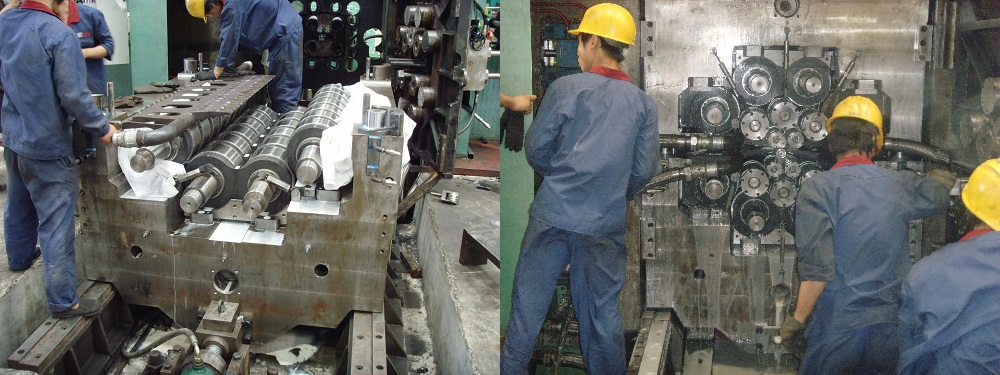Cold Rolling Mill Technology Sharing - Treatment of Slip Problem of Reversible Cold Rolling Mill
In the process of cold rolling, the lubrication system is relatively complete and prone to rolling mill slipping. The phenomenon is the relative slipping between strip and roll. In essence, the rolling deformation zone is completely replaced by the front sliding zone or the back slipping zone. The consequences of slipping affect the surface quality of the strip, damage the roll, deviation of the strip and affect the rolling speed. In this paper, the slippage phenomenon of single stand reversible rolling mill lubricated by emulsion is analyzed, and the experience of improving process lubrication is summarized by combining the theory of slippage factor and actual production.

1. Characteristics of rolling slipping:
The best way to determine the slipping is to observe the roller speed and the rack outlet strip speed difference. When the roll line speed is greater than the exit speed, we identify it as rolling mill slipping.
1) Usually the slip problem occurs when the rolling part is thick and the amount of pressure is large, and the lubrication requirement is not high, usually the second and third times are more. The first pass is less prone to slip than the second and third passes because of the larger surface roughness, lower rolling speed and lower inlet tension of cold rolling materials. After tracking a cold rolling mill, the number of slipping occurred in 2 and 3 passes accounted for 87%.
2) Slipping seriously affects the service cycle of rollers. Take a factory as an example, the normal service cycle of 1 pair of work rollers is 120km, but when slipping, serious side waves and deviation appear at 80km. By slowing down the speed or reducing the inlet tension, the shape of the plate will be improved immediately. When the roughness of the upper roller is small, it is more obvious to slipping.
3) The abnormal vibration of the rolling mill is essentially the unstable strip of rolling tension and the high frequency jitter of the stand.
2. Influence factors of rolling slipping problem
1) Roll roughness: roll roughness mainly affects the friction coefficient between rolled parts and rolls. With the reduction of roll roughness, the friction coefficient decreases, and the friction coefficient decreases, the neutral surface of the deformation zone will move towards the rolling exit direction. When it moves away from the deformation zone, the roll speed will be greater than the speed of the strip at the exit and slip.
2) Rolling speed: With the increase of rolling speed, the thicker the oil film formed between the roll and the strip, the smaller the friction coefficient, and the more likely to slip.
3) Lubrication state: lubrication state includes the variety, concentration and temperature of rolling liquid, etc. Generally, the higher the concentration of the same rolling fluid, the more oil in the deformation zone, the smaller the friction coefficient. The higher the temperature is, the faster the oil-water separation is, the easier the oil film in the deformation zone is to form and the smaller the friction coefficient is.
4) Rolling schedule: a Absolute reduction: According to the elastic-plastic mechanics theory, when the absolute reduction is larger, the bite Angle is larger, and the rolling force on the opposite side of the rolling direction is larger, and the rolling part and roll are more prone to relative sliding. B, tension: after tension and rolling force to provide the friction is the opposite, so the greater the tension is prone to relative sliding to slip. Similarly, the smaller the front tension, the more likely it is to slip.
3. Process optimization of rolling slipping
According to the above analysis of rolling factor, the following measures are summarized:
1) Increase roll roughness appropriately. Usually the roughness of finished pass roller is 0.45-0.55μm and the roughness of strip steel is about 0.35μm. In the rolling process, the roughness of the roll will be gradually reduced. Therefore, in the first roll change of the reversible mill, the roughness of the roll will decrease after the first few rolls without affecting the final surface quality.
2) Reasonable selection of rolling fluid. According to the speed of the rolling mill, rolling specifications, thickness of the thinnest product and other parameters comprehensive analysis.
3) Reasonable control of rolling fluid concentration. Usually controlled in 1% - 3%, when slipping appropriate water to reduce the use of concentration.
4) Reasonable control of rolling liquid temperature. Usually controlled at 45-60℃. When the temperature is high, start the cooling device properly.
5) Reasonable arrangement and uniform distribution of rolling schedule. The absolute pressure down of a certain pass should be appropriately reduced.
6) Reasonable adjustment of inlet and outlet tension. When slipping, under the condition of ensuring the current load of the crimping motor and the crimping quality, the inlet tension is appropriately reduced and the outlet tension is appropriately increased.















 WhatsApp
WhatsApp